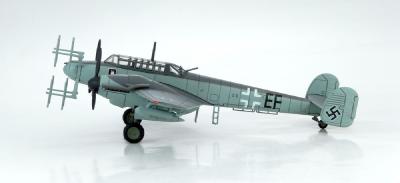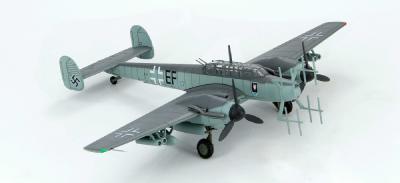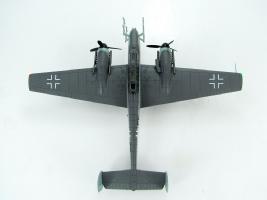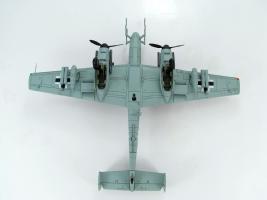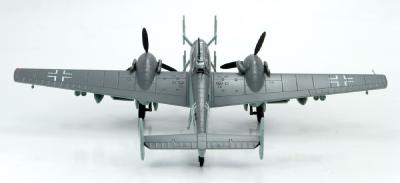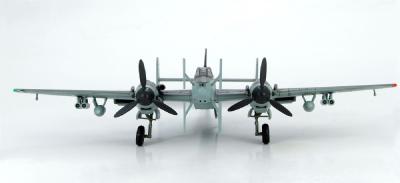Hobby Master Archive
Air Power Propellers 1/72
Bf-110
Bf-110-G4, Heinz-Wolfgang Schnaufer, G9+EF, IV./NJG 1, St. Trond Belgium, October 1944
Hobby Master 1/72 Air Power Series HA1803 Bf-110G-4, G9+EF, Heinz-Wolfgang Schnaufer IV./NJG 1, St. Trond, Belgium, October 1944
Superb detailing in 1/72 scale. Pre-painted with pad applied markings. Fully assembled. Supplied weapons are not permanently attached. Display stand included. Option to display model with wheels up or down. Minimum use of plastic. Very collectable.
THESE ARE PRE-PRODUCTION PICTURES, NOT THE FINAL PRODUCT
Powerplant: 2 X Daimler Benz DB 605B 12 cylinder inverted-vee liquid-cooled engines rated @ 1,475 hp (1,099 kw) @ 2,800 rpm for take-off and, 1,355 hp (1,010 kw) @ 2,800 rpm @ 18,700 ft. (5,699 m).
Dimensions: Wing Span - 53 ft. 4 7/8 in. (16.27 m) Length - 41 ft. 6 3/4 in. (12.67 m) Height - 13 ft. 1 1/4 in. (4.0 m) Weight Empty - 10,970 lb (4,975 kg) Maximum Loaded - 21,800 lb. (9,888 kg)
Performance: Maximum Speed - 349 mph (562 kph) at 22,965 ft (7,000m) Range - 528 miles (850 km) at 304 mph (490kph) at 16,400 ft. (5,000m) Initial climb - to 5,500m (18,045 ft.) in 8 minutes Service Ceiling - 32,800 ft. (10,000m)
Armament: Nose - Fixed firing forward - 2 X 30mm Mk 108 Cannon with 135 rounds per gun, 2 X 20mm MG 151 Cannon with 300 rounds (port) and 350 rounds (starboard) plus - 2 X 20mm MG 151 Cannon in Schrage Musik installation (Firing Obliquely forward) Or 2 X 7.92mm MG 81 in rear cockpit Optional U1 modification - Waffenwanne 151Z ventral tray housing two forward firing 20mm MG151 cannon Avionics: FuG 10P R/T Set FuB1 2F Airfield blind approach receiver FuG 227/1 Flensburg Homing System Used to home in on British Monica tail warning radar emissions.(Only fitted to some aircraft) FuG 212 Lichtenstein C-1 Radar FuG 220b Lichtenstein SN-2 Radar
When used as a heavy-fighter-bomber the Bf-110 had mixed results. But when airborne radar was added along with nose-mounted armament and Schrage Musik (the upward firing cannons) the Bf-110 became a deadly nighttime predator for British bombers. By the end of 1942 Germany had almost 400 night-fighters of which 75% were Bf-110s. These deadly hunters managed to destroy almost 1300 aircraft during 1942 alone. As the British bomber attacks increased in size and frequency the Bf-110 was simply overwhelmed and couldn’t cope allowing more and more bombs to make it to German cities.
In November 1939 the 17 year old Heinz-Wolfgang Schnaufer joined the Luftwaffe and in January 1942 was based at Saint-Trond Belgium where he became known as “The Night Ghost Of Saint-Trond”. By the end of WWII the 23-year old Schnaufer was NJG-1 Kommandeur with several medals having flown 164 missions and 121 victories making him the top scoring Nachtjager pilot. On February 21, 1945 he added 9 RAF bombers to his victories. After surviving WWII it is almost ironic that Schnaufer died at age 28 in a car accident.
| Added to archive | 2015-11-19 |
| Last modified | 2015-11-19 |
| Leaflet | 2008-02-01 February 2008 |

